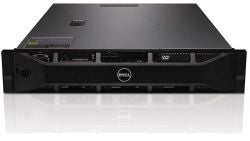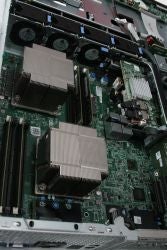Rack-mounted servers have long since moved into the commodity product stage. If you were to look at 2U servers available from traditional sources like Dell, HP and Lenovo, you’ll find pretty similar capabilities in terms of processor, memory and storage density. Price varies widely depending on configuration, but similarly equipped systems from all three vendors tend to be relatively close. Differentiation is difficult unless you start looking at options like AMD processors.
|
|
 |
| Dell PowerEdge R515 |
Although rackmount servers are considered commodity offerings, demand for them continues to rise. The server hardware vendors are happy to oblige, as they attempt to differentiate their wares. The PowerEdge R515 from Dell is a prime example.
Dell’s PowerEdge R515 server series offers 6-core AMD Opteron 4100 series processors for up to 12 total cores in a single box. That’s four more cores than a similarly equipped Intel-based system. An overall performance comparison of AMD versus Intel is highly dependent on the workload and can vary significantly depending on any number of factors. For highly virtualized environments, the number of available cores, along with memory, is directly related to how many virtual machine instances a single 2U server can reasonably handle.
PowerEdge R515 Options Abound
When it comes to choosing options for the R515, you definitely must have a good idea of your usage scenario beforehand. Memory and processors are pretty straightforward. The PowerEdge R515 has a total of eight DIMM slots for a potential total of a whopping 128GB of memory when using 16 GB cards. With the price of 4GB DIMMs dropping dramatically of late, you can load it up with 32 GB of memory without breaking your budget. After that, it can get complicated really quickly. The device we tested was shipped with 8GB of RAM, but as you can see from Figure 1, it’s easily upgradable.
 |
| Figure 1 Inside the PowerEdge R515 |
Storage is one good example of where you must know what you plan on doing with the machine. Storage options include standard SATA, serial attached SCSI (SAS) with drive speeds of 7.2K, 10K and 15K RPM, and solid state SATA drives in 50 and 100 GB sizes. You also have a choice of either an 8-bay or 12-bay chassis for a maximum of 25 TB of storage. The other decision you must make when it comes to storage is the type of controller you’ll use. Standard options include PERC RAID controllers for both internal and external drives. You could also choose an external Host Bus Adapter (HBA) if you’re looking to build up a storage front end.
Communications options are the broadest of all, with choices available from Broadcom, Brocade, Emulex, Intel and Qlogic. Both multi-port Gigabit and 10-Gigabit Ethernet boards provide ultrahigh speed connectivity options. For high-speed storage connectivity, there are single- and dual-port Fibre Channel HBAs available from multiple vendors. Standard options include two Gigabit Ethernet ports on the rear of the chassis.
Reliability and Maintainability of the PowerEdge R515
Engineering for reliability has been a hallmark of Dell’s server line, and the R515 is no exception. As Figure 1 illustrates, when you open the case and look inside, you see hints of that in the placement and numbers of fans, the distribution of components and the dual power supply chassis. You also see the ease of maintaining this box from access to memory to the easy and quick release of components. Even removing the top of the case shows off good design in the single-latch and screw-lock. Dell went to extreme lengths to minimize the power requirements of the PowerEdge R515 using things like low-wattage processors, support for low-voltage DIMMS and highly efficient fans that adjust their speed depending on server workload levels.
Most, if not all, rack-mounted servers are destined to be controlled remotely. Dell has almost as many options for managing its servers as it does hardware configurations. One of the first things you notice when you boot the R515 is the option to configure a remote management service. One nice touch is the inclusion of a VGA port on the front panel of the 8-bay R515. This makes it simple to take direct control of a server using a monitor and USB keyboard or mouse without having to get access to the rear of the cabinet. There are also two USB ports on the front for easy access.
iDRAC 6 is the latest incarnation of the Dell Remote Access Controller, providing out-of-band management and control independent of any local operating system. The front panel LCD is controlled by iDRAC 6, and it provides access to key setup information using a tiny 128X20 pixel display and labeled buttons. You can view and edit things like the static management IP address without needing any additional hardware. Multi-colored LEDs on the rear panel offer technicians a quick visual indication of potential problems.
Up and Running
The R515 review unit we received came with no OS or DVD drive, which is not a big deal as you can create a bootable USB drive with the installation files for Windows Server 2008 R2 using two commands. This assumes you have formatted the USB key in the fat32 format. With the DVD mounted as drive D: and a 4GB USB drive as E: you would type the following in a command window with administrator privileges:
D:bootbootsect /nt60 E: Xcopy D:*.* /s/e/f E: |
That’s all there is to it. With that done, we were able to use the F11 key to drop into a boot menu, allowing us to choose the USB key from the disk menu and proceed to install Windows Server 2008 R2. Total installation time from start to finish with the USB key method was under 15 minutes. You could just as easily attach an external USB-DVD drive and install from a DVD or CD-ROM.
Bottom Line
The Dell R515 is a solidly built 2U server with a seemingly infinite number of options. Pricing depends on the actual configuration, but you can specify a solidly performing server capable of handling most any workload for a very reasonable price. Add to that Dell’s service, and you have a great product that should serve your needs well.
Dell’s management infrastructure (iDRAC 6) provides the remote control capabilities needed to do things like remote boot your server from across the country or across the world. It also provides insight into things like operating temperature and power consumption to keep tabs on the health and status of your server. This box is definitely worth a look if you’re in the market for a 2U server.

